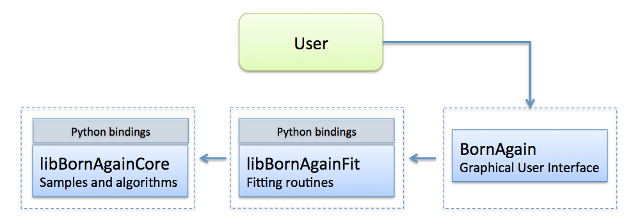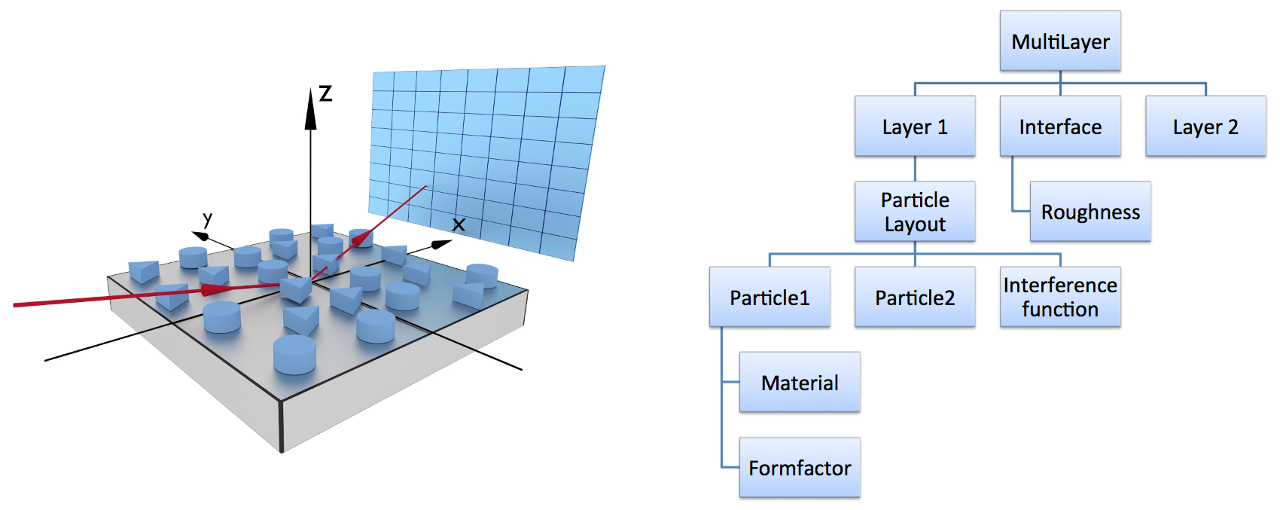BornAgain is a multi-platform framework available in Windows, MacOS and Linux. The C++ code, all configuration files, tests and Python scripts are all open-source, available at https://jugit.fz-juelich.de/mlz/bornagain.
The framework consists of two shared libraries written in C++, libBornAgainCore and libBornAgainFit, and a standalone graphical user interface. Thanks to the Python bindings the libraries can be imported into Python as external modules. The library libBornAgainCore defines the data structures and provides the algorithms needed to set up a sample model and to run a simulation. The library libBornAgainFit contains several minimization engines and interfaces to each of them, allowing the user to fit real data with the model previously defined.

BornAgain depends on a few external and well established open-source libraries: boost, GNU Scientific Library, Eigen, Fast Fourier Transformation and Qt5 libraries. They must be installed on the system to run BornAgain on Unix platforms. In the case of Windows and MacOS they are added to the system automatically during the installation of BornAgain.
The fitting library includes a number of minimization algorithms from ROOT Framework from High Energy Particle Physics and from GNU Scientific Library. This code is shipped with the library itself, so no external dependencies are involved.
In simple cases the user interacts with the framework through a graphical user interface.

The advanced approach, allowing much higher levels of flexibility, consists in using BornAgain from Python. The user creates a Python script with a sample description and the simulation settings using the BornAgain API. The user then runs the simulation by executing the script in the Python interpreter. He assesses the simulation results using the graphics or analysis library of his choice, e.g. Python + numpy + matplotlib.

BornAgain uses an object-oriented approach in the simulation description to achieve modularity and extensibility. The user defines the sample structure, the beam and the detector characteristics using building blocks – classes – defined in the core libraries of the framework. These building blocks are combined by the user into a hierarchical tree of objects representing the simulation.
For example, to simulate the scattering from a mixture of cylinders and prisms deposited on a substrate, the following tree of objects has to be created.

The parent MultiLayer object represents the sample and contains three children: the semi-infinite air layer, the semi-infinite substrate layer, and the interface between them. The air layer contains the so-called ParticleLayout object, which holds information about the particles populating the layer and the interference between them. Each particle is fully defined via its children: the material the particle is made of and the form factor representing the particle’s shape.
In practice, for the users working from the graphical user interface the sample construction involves the usage of a drag-and-drop editor, where items of certain types should be placed on the canvas and connected with each other in order to create the sample structure (see figure below, on the left). For the users working from Python, a script similar to the one shown on the right of the figure below has to be created.

Both approaches are explained in details in the following sections of this documentation.